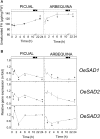Transcriptional Regulation of Stearoyl-Acyl Carrier Protein Desaturase Genes in Response to Abiotic Stresses Leads to Changes in the Unsaturated Fatty Acids Composition of Olive Mesocarp
- PMID: 30891055
- PMCID: PMC6411816
- DOI: 10.3389/fpls.2019.00251
Transcriptional Regulation of Stearoyl-Acyl Carrier Protein Desaturase Genes in Response to Abiotic Stresses Leads to Changes in the Unsaturated Fatty Acids Composition of Olive Mesocarp
Abstract
In higher plants, the stearoyl-acyl carrier protein desaturase (SAD) catalyzes the first desaturation step leading to oleic acid, which can be further desaturated to linoleic and α-linolenic acids. Therefore, SAD plays an essential role in determining the overall content of unsaturated fatty acids (UFA). We have investigated how SAD genes expression and UFA composition are regulated in olive (Olea europaea) mesocarp tissue from Picual and Arbequina cultivars in response to different abiotic stresses. The results showed that olive SAD genes are transcriptionally regulated by temperature, darkness and wounding. The increase in SAD genes expression levels observed in Picual mesocarp exposed to low temperature brought about a modification in the UFA content of microsomal membrane lipids. In addition, darkness caused the down-regulation of SAD genes transcripts, together with a decrease in the UFA content of chloroplast lipids. The differential role of olive SAD genes in the wounding response was also demonstrated. These data point out that different environmental stresses can modify the UFA composition of olive mesocarp through the transcriptional regulation of SAD genes, affecting olive oil quality.
Keywords: Olea europaea; abiotic stress; gene expression; olive; stearoyl-ACP desaturase; unsaturated fatty acids.
Figures





Similar articles
-
Transcriptional Analysis of Stearoyl-Acyl Carrier Protein Desaturase Genes from Olive (Olea europaea) in Relation to the Oleic Acid Content of the Virgin Olive Oil.J Agric Food Chem. 2016 Oct 19;64(41):7770-7781. doi: 10.1021/acs.jafc.6b02963. Epub 2016 Oct 11. J Agric Food Chem. 2016. PMID: 27690417
-
Differential Contribution of Endoplasmic Reticulum and Chloroplast ω-3 Fatty Acid Desaturase Genes to the Linolenic Acid Content of Olive (Olea europaea) Fruit.Plant Cell Physiol. 2016 Jan;57(1):138-51. doi: 10.1093/pcp/pcv159. Epub 2015 Oct 29. Plant Cell Physiol. 2016. PMID: 26514651
-
Effect of different environmental stresses on the expression of oleate desaturase genes and fatty acid composition in olive fruit.Phytochemistry. 2011 Feb;72(2-3):178-87. doi: 10.1016/j.phytochem.2010.11.026. Epub 2010 Dec 29. Phytochemistry. 2011. PMID: 21194717
-
Unsaturated Lipids Change in Olive Tree Drupe and Seed during Fruit Development and in Response to Cold-Stress and Acclimation.Int J Mol Sci. 2016 Nov 12;17(11):1889. doi: 10.3390/ijms17111889. Int J Mol Sci. 2016. PMID: 27845749 Free PMC article. Review.
-
Plant Unsaturated Fatty Acids: Biosynthesis and Regulation.Front Plant Sci. 2020 Apr 23;11:390. doi: 10.3389/fpls.2020.00390. eCollection 2020. Front Plant Sci. 2020. PMID: 32425958 Free PMC article. Review.
Cited by
-
Transcriptomic Analysis During Olive Fruit Development and Expression Profiling of Fatty Acid Desaturase Genes.Int J Mol Sci. 2024 Oct 17;25(20):11150. doi: 10.3390/ijms252011150. Int J Mol Sci. 2024. PMID: 39456931 Free PMC article.
-
Changes in the Flower and Leaf Proteome of Common Buckwheat (Fagopyrum esculentum Moench) under High Temperature.Int J Mol Sci. 2021 Mar 6;22(5):2678. doi: 10.3390/ijms22052678. Int J Mol Sci. 2021. PMID: 33800930 Free PMC article.
-
Tung tree stearoyl-acyl carrier protein Δ9 desaturase improves oil content and cold resistance of Arabidopsis and Saccharomyces cerevisiae.Front Plant Sci. 2023 Mar 7;14:1144853. doi: 10.3389/fpls.2023.1144853. eCollection 2023. Front Plant Sci. 2023. PMID: 36959932 Free PMC article.
-
Whole genome resequencing unveils low-temperature stress tolerance specific genomic variations in jute (Corchorus sp.).J Genet Eng Biotechnol. 2024 Jun;22(2):100376. doi: 10.1016/j.jgeb.2024.100376. Epub 2024 Apr 9. J Genet Eng Biotechnol. 2024. PMID: 38797551 Free PMC article.
-
Molecular Cloning and Characterization of FAD6 Gene from Chia (Salvia hispanica L.).Biochem Genet. 2021 Oct;59(5):1295-1310. doi: 10.1007/s10528-021-10063-w. Epub 2021 Apr 1. Biochem Genet. 2021. PMID: 33797013
References
-
- Baldoni L., Cultrera N. G., Mariotti R., Ricciolini C., Arcioni S., Vendramin G. G., et al. (2009). A consensus list of microsatellite marker for olive genotyping. Mol. Breed. 24 213–231. 10.1007/s11032-009-9285-8 - DOI
-
- Banilas G., Moressis A., Nikoloudakes N., Hatzopoulos P. (2005). Spatial and temporal expressions of two distinct oleate desaturases from olive (Olea europaea L.). Plant Sci. 168 547–555. 10.1016/j.plantsci.2004.09.026 - DOI
LinkOut - more resources
Full Text Sources

